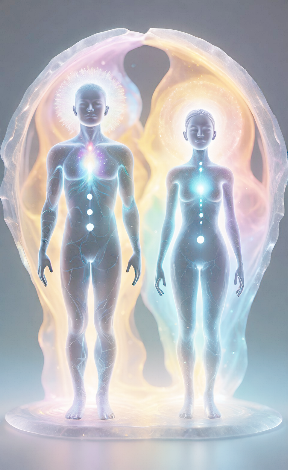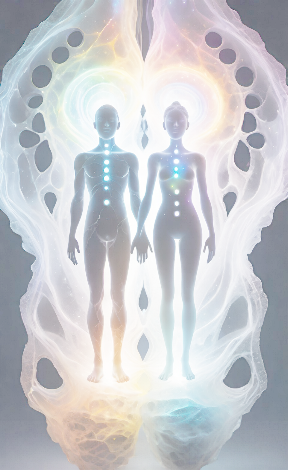Pair, Family, Collective, and State Egregor
It's not enough to take off your last shirt – you also have to smile so that it's taken.
Avessalom Podvodny.
Pair Egregor: Subtle Interaction and Hidden Goals
Any interaction with another person means contact with their leading (i.e., the one they are serving at that moment) and, to a lesser extent, their karmic egregor. In turn, behind the person stands their own leading egregor, and, of course, both sides, if one allows for a legal turn of phrase, each possess a semi-controlled subtle seven, so that in the most ordinary dialogue, at least two egregors and fourteen subtle figures participate directly (actively or passively), usually behaving quite casually.
Goals and Aspects of Pair Interaction
Every pair interaction has several goals, or, if the teleological emphasis is unpleasant to the reader, several aspects. The main one is the exchange of information-energy flows between the leading egregors, but in the course of communication, some side effects may also arise, for example, mutual learning, and sometimes children are born.
During any communication between two people, a certain meditation arises, meaning their assembly points shift to positions from which the partner is somehow visible, and the pair is surrounded by a certain subtle cloud, which includes the channels of the partners' leading egregors. Through this cloud, a two-way exchange of information occurs between the egregors. The better the partners understand each other, the more intense the exchange between the egregors can be, if, of course, they have something to say to each other.
Why Do Egregors Use People for Communication?
Here, the reader might ask a reasonable question: why is it so complicated? Can't egregors communicate directly with each other, thus bypassing human interaction altogether? Of course, they can, and for the most part, that's what they do. However, such interaction without a material carrier has its limits, and sometimes it turns out to be insufficient. Moreover, one shouldn't forget that a person, by virtue of their high evolutionary position, is fundamentally capable of letting a very strong and wide flow pass through them, so egregors sometimes find it convenient to use the opportunities provided by human contacts.
People, however, are somewhat puzzled why their communication is so intense and seems to have an additional meaning. From the perspective of egregors communicating through people, purely human interactions are, on the contrary, a side effect, and people somehow don't understand this and don't want to understand it, as if to spite both themselves and the egregors. Any contact with another person is difficult and unsafe in itself, and to interest a person in it, an egregor needs to expend considerable effort. As a rule, two types of motivations are used: the stick and the carrot. Without them, a person, of course, would prefer to sit quietly in their corner and not venture out.
Personal Pair Egregor: Features and Challenges
However, besides the motivations of the leading and karmic egregors, a special communication situation often arises when a personal pair egregor, almost isolated from other egregors, is created in the subtle world. This egregor is meant to implement a program of intensive information exchange and mutual learning (less often – joint activity).
When engaging in the materialization program of a pair egregor, it's important to understand the following:
Life is largely a great mystery, and personal relationships are doubly so. This is the first lesson a person hoping for cultural communication with their peers must learn. For interactions between partners, the pair egregor often provides a very specific time within which the pair must complete their task. If this doesn't happen, the relationship narrative either painfully breaks off, leaving the partners with a feeling of dissatisfaction with themselves and each other (often with the world in general, even God), or the social relationships drag on but are deprived of energetic support and are unsanctioned (untimely). Therefore, they attract the attention of Gagthungr, who imbues them with his meaning, connecting the pair to one of his egregors.
It's also incredibly important to have a correct distribution of roles, always hinted at by the pair egregor, but often unnoticed or consciously ignored by people. Moreover, there's always the temptation to manipulate a partner using the energy of the pair egregor, which can spoil or even destroy the strongest and most promising pair programs. The fact is that, in principle, in pair interactions, partners, from the perspective of the pair egregor, are often interchangeable. What one refuses to do is shifted by the egregor onto the shoulders of the other – but this cannot go on indefinitely. Regular imbalance ends with the death of the egregor and the disruption of the interaction program. Speculation is especially common in programs of mutual study and adaptation; saying (aloud or to oneself): "Love me when I'm dark, because anyone will love me when I'm light" or "You need it – you adapt, and I'll live as I please" – is a direct crime against the pair egregor, and the consequences, often in the form of its demise, are not long in coming.
Generally, the pair egregor (one often wants to say "little egregor") is, as a rule, a very tender creation, with a quiet voice, but sometimes immense possibilities. Correct pair work is a concept practically nonexistent in civilization and almost undescribed in spiritual texts, both Western and Eastern. In family life, spouses most often represent powerful black-teacher figures for each other, although karmically something entirely different might be intended.
Family Egregor: Love, Consciousness Expansion, and Karmic Tasks
Marriages, as is well known, are made in heaven. The formation of a family corresponds to the meeting of young people of opposite sexes and the emergence of a certain kind of attraction between them, most often called love, which leads to a huge number of misunderstandings. Love is the state of connecting to any strong energy channel: one can love a pork chop, a sister, a mother, a homeland, poetry, a mistress, a wife, a daughter, and all these are different states that human consciousness can by no means always distinguish.
In principle, the advent of love is a sign by which a person can firmly say: I am being connected to a new egregor; a lot of work lies ahead. The traditional Western cultural view of love as a gift of fate is an extreme delusion. Analogously, the disappearance of love is associated with the exhaustion of a joint karmic program (or with the end of the time interval allotted for it).
Consciousness Expansion and Conflict with the Ego
The opening of a wide channel to a new egregor (of a future family) is accompanied by two closely related events: the expansion of consciousness and the intensification of energy. But while the intensification of energy is usually experienced positively and eagerly celebrated by poets ("her eyes glowed, and roses bloomed on her cheeks," "the world before his eyes seemed to sparkle with a thousand colors" and so on), the situation with the expansion of consciousness is not so simple.
Consciousness is expanded by the family egregor forcefully, and the egoic egregor may not be prepared for this. Suddenly, another person becomes essentially important. "I can't live without you, I constantly think about you," – these are typical symptoms of consciousness expansion.
The new state is an infringement on the egoic egregor: the person becomes dependent on the other – their presence, mood, state, and so on. An inevitable problem arises: which egregor to serve? Its solution is always individual and lies between two points: complete subordination of the egoic egregor to the family egregor and vice versa. In the first case, the person becomes a slave to the family; in the second, they become its dictator and, as it's called, drain all its vitality. Somewhere between these extreme positions, each individual finds their place.
Evolutionary Task: Overcoming Egocentrism
In connection with the problem of choice between serving the egoic and family egregors, the following should be noted. One of the main goals of evolutionary development is the expansion of consciousness, and therefore, its conscious narrowing is a karmic crime and heavily burdens subsequent karma. When a person hears the call of the family egregor, the latter (forcefully) expands their consciousness, forcing them to see the other – their pains, joys, sorrows, and impulses, as their own. This forces the person to displace the egoic egregor, including others' interests in their own. The egoic egregor begins a struggle for its infringed interests, tempting the person to narrow their consciousness back, excluding the other from it. It is precisely the overcoming of this temptation that is the main evolutionary task of a person in the initial period of forming relationships within a family. It is impossible not to give a piece of bread while looking into the eyes of someone dying of hunger; it's quite another matter to walk past, turning away...
Building a "House" in the Subtle World and Its Temptations
When two people meet and begin to interact with each other, they are (regardless of the external circumstances that may accompany this) essentially engaged in building a house (in the subtle world) for a new, or emerging, collective. The more they trust each other, the more diverse the situations in which they have tested and verified each other, the better they can understand each other, the stronger the walls of this house, the more comfort it creates for them, the better they get along with each other, now without any effort on their part: they can reap the fruits of their labors, and precisely here lies a dangerous temptation. For no energy is given to a person just like that; it always implies its use in the evolutionary process.
Outwardly, it looks like this: while we were getting to know each other and overcoming difficulties together, everything was so wonderful. Why is it not like that now? Where has the immediate joy of communication gone? It is much more correct to ask the question: where did it come from?
After all, the joint karmic program at the moment of building the house can sharply turn, for example, requiring the acquisition of children. But in any case, the egregor will not tolerate its energy being used "for pleasure" (to which, in all forms without exception, humanity is so prone).
However, a shift in the karmic program might not be the most difficult test; a great temptation often arises at the moment of its completion. Then the energy accompanying the interaction disappears forever, and it's impossible to recover it by any means. If a person has become attached to it, they will suffer greatly, depending on their temperament – quietly or loudly – trying to scrape through the cupboards or corners of the shared refrigerator. But alas! Their efforts are futile; the cold hand of karma turns their attention in another direction...
Collective Egregor: Birth and Service
An egregor always arises before the corresponding organization. It creates specific conditions on Earth, sends appropriate energy flows to the people it has chosen, and the collective emerges as if "out of nothing" and "by itself."
At a certain point, a small group of people or sometimes one person – L. Gumilyov calls them passionaries ("passionate ones") – appear, possessing extraordinary psychic strength and being obsessed with a certain idea. Around these passionaries, a number of followers quickly gather, who become infected with the energy and ideas of the passionaries and can radiate it themselves for some time. A young collective is distinguished precisely by a high percentage of passionaries, and this helps it to unite and quickly conquer and defend its place under the sun, which is quite difficult as long as the group's size is small.
The egregor supplies the passionary serving it with power and an idea, and in return demands one thing – self-sacrifice. The question of voluntary service does not arise in the case of passionaries – they are, as it were, on a short leash, doing exactly what the egregor requires, and paying, as a rule, with their lives, which are, however, quite vivid.
Controlling Passionaries and Loss of Connection
Leading egregors do not ask for a person's consent to participate in certain programs. They simply place them in particular situations, evoke certain feelings and thoughts – and then struggle or swim as you wish.
The passionary themselves, of course, may think that they are living their life as they wish, but nevertheless, they cannot (and do not want to) remove from themselves the devouring idea, often disguised as a thirst for power or money. Their main passion, idea, and desire are rigidly programmed by the egregor. At the same time, the egregor gives them power over the world in the form of great psychic strength, more precisely, a powerful communication channel through which information and energy flow from the egregor to the passionary... as long as the latter is needed by the egregor. When for one reason or another the service ceases, the egregor partially or completely blocks this channel.
Thus, when a woman goes through menopause, her channel of communication with a certain egregor (its symbol is Yin, or the universal feminine principle) is blocked, and she loses her specific "female" attractiveness, that is, psychic (magical) power over the male sex.
State Egregor: Tasks, Governance, and Development
The specificity of the state egregor lies in the fact that it represents the coarsest, so to speak, material type of egregor; its tasks are essentially very limited: maintaining the life of the human collective and protecting it from chaotic tendencies, both external and internal.
The level of autonomy of the egregor's parts is very important from the perspective of its existence and development. Centralization is necessary for coordinating actions, that is, overcoming the chaotic principle (otherwise, the well-known effect of the swan, pike, and crab arises). On the other hand, the development of a large egregor is largely realized through the development of its sub-egregors, which therefore need a certain freedom, and its flexibility and plasticity are determined by their level of freedom.
Governance as Coercion and the Role of Style
The governance of an egregor is always a form of coercion; it is especially experienced as coercion when the energy flow operates at a frequency different from its characteristic frequency. This means the egregor must reorganize and somehow adapt the received information and energy, which is not easy and always undesirable. Imagine a lovesick high school student explaining her truancy to the principal by the necessity of a date with her beloved.
Generally, governance and creativity do not align well with each other, as creativity is the search for new information-energy channels, while governance is the fixation of existing ones. Therefore, style, which is the characteristic frequency of the governance channel, is very important.
It's clear why the increase in the evolutionary level of a large egregor is such a difficult and slow process: it requires the simultaneous and coordinated evolutionary growth of all egregors included in its composition, and the adaptation of all information-energy channels to higher frequencies.








